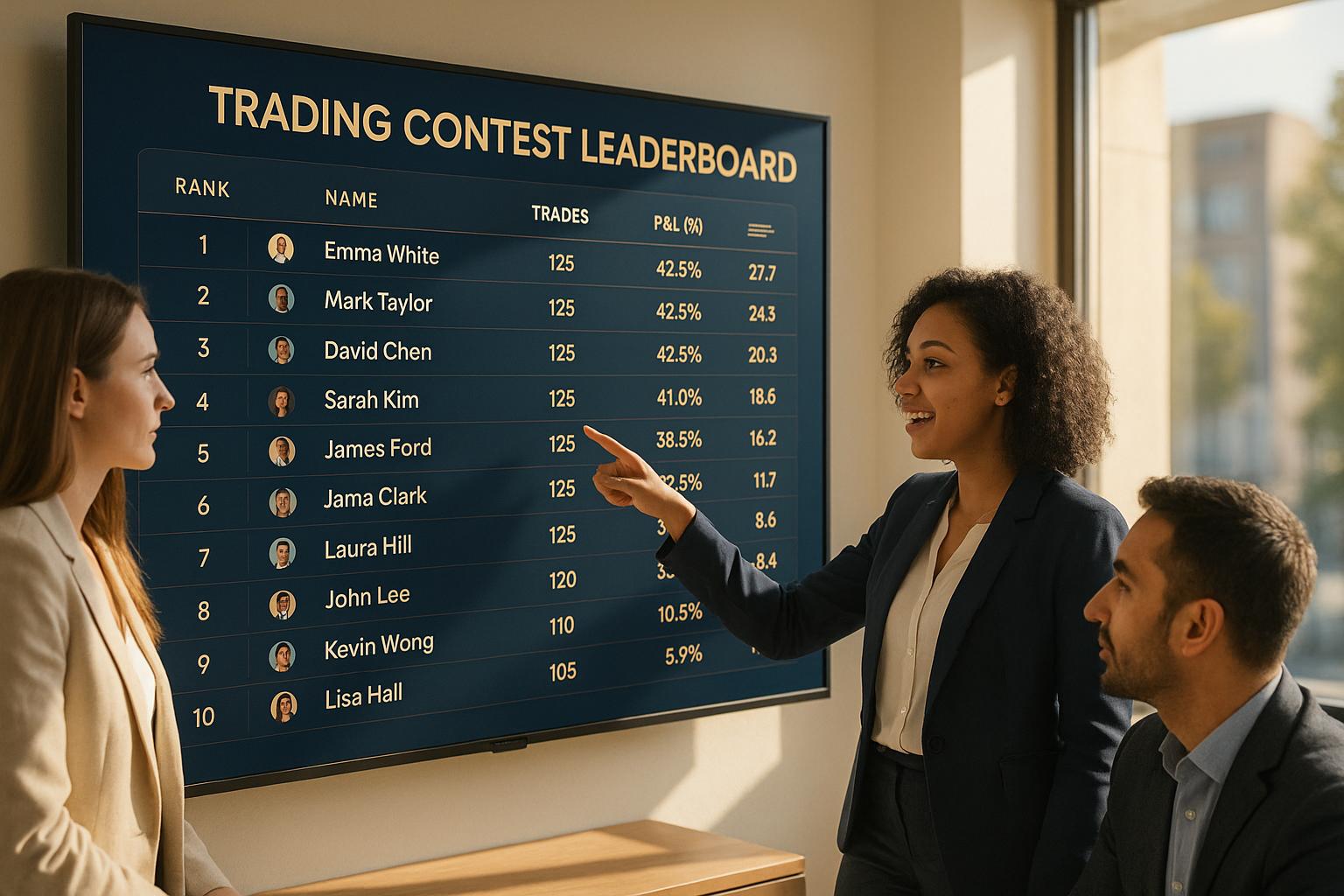- Why Trading Competitions? They help grow accounts by 25%, improve trader skills (78% of participants), and increase trading volume by 15-30%.
- Key Steps:
- Set Goals: Define targets like user sign-ups, trading volume boosts, or community engagement.
- Choose a Platform: Look for real-time leaderboards, MT4/MT5 integration, and strong security. Costs range from $79.99 to $750/month.
- Set Rules: Clarify trading limits, risk controls, and prize structures to ensure fairness.
- Build Systems: Automate user registration, enforce rules, and provide participant support.
- Measure Success: Use metrics like profit/loss and engagement rates to evaluate performance.
| Platform | Monthly Cost | Best For |
|---|---|---|
| TradePlayTech | $500 | Brokers, institutions |
| THENA | $750 | Mid-sized competitions |
| Bookmap | $79.99 | Small-scale events |
Follow these steps to create a smooth, engaging competition that benefits both organizers and participants.
How To Register and Trade in a BullRush Trading Competition
Step 1: Select Your Contest Platform
The platform you choose plays a huge role in the success of your trading competition. Studies show that the platform directly affects participant engagement and completion rates. Look for features that align with your competition goals outlined in Step 1.
Key Platform Features to Look For
When comparing platforms, prioritize these technical features that are crucial for a smooth and effective competition:
Trading Essentials:
- Real-time leaderboards to keep participants engaged.
- Integration with major trading platforms like MT4, MT5, and DXTrade.
- Automated performance tracking for accurate scoring.
- Support for multiple asset classes to allow diverse competition structures.
Security and Compliance:
- Two-factor authentication to secure participant accounts.
- Encrypted data transmission to protect sensitive information.
- Automated trade verification to ensure fair play.
- Strong security measures to safeguard both participants and your brand.
For context, 92% of platforms support MT4/MT5 integration, which is considered an industry standard. Additionally, 78% of competition organizers rate real-time leaderboards as the most important feature.
Comparing Platform Options and Costs
Here’s a quick look at some popular platforms and their pricing:
| Platform | Monthly Cost | Best For |
|---|---|---|
| TradePlayTech | $500 | Brokers and large institutions |
| THENA | $750 | Mid-sized competitions |
| Bookmap | $79.99 | Small-scale events |
When making your decision, keep these factors in mind:
- Scalability: Ensure the platform can handle the number of participants you expect. Cloud-based platforms are often better for scaling.
- Customer Support: Check for 24/7 support availability. For example, TradePlayTech has a 4.7/5 rating for customer service, while THENA scores 4.0/5 based on user feedback.
- Cost Breakdown: Look beyond the base price. Additional fees may apply for:
- API access
- Custom branding
- Advanced analytics
- Running multiple competitions simultaneously
Pricing can vary widely, starting at $500/month for basic setups and going beyond $10,000/month for enterprise-level solutions. Make sure the platform fits both your budget and participant needs.
Once your platform is set, the next step is to create rules that keep the competition fair and engaging.
Step 2: Create Competition Rules
Once you've chosen your platform, the next step is to establish clear rules. These rules are essential for ensuring your trading competition runs smoothly and fairly.
Basic Rules and Requirements
Your competition rules should cover both the technical and behavioral aspects of trading. Here’s what to include:
Time and Trading Parameters
- Define the competition's start and end dates, including specific trading hours.
- Set minimum trading activity (e.g., 10 contracts per day).
- Specify allowed trading instruments and note any restrictions.
- Limit leverage, such as 1:100 for FX pairs or 1:30 for commodities.
Risk Management Controls
- Enforce a daily loss limit of 5% of the initial balance.
- Cap the maximum drawdown at 10% of the starting account value.
- Restrict position sizes, typically to 10% per single position.
- Require stop-loss orders on all trades.
Participation Requirements
- Ensure participants trade actively for at least 5 days.
- Ban specific practices, like algorithmic trading.
"Implementing proper risk management rules isn't just about protecting participants - it's about creating an environment that mirrors real-world trading conditions. This helps develop better traders while maintaining competition integrity." - CME Group University Trading Challenge Rules and Regulations, 2024
Prize Structure
Your prize structure should align with the competition's goals. For example, funded accounts can help discover new talent, while educational prizes focus on skill-building.
| Prize Category | Description |
|---|---|
| Grand Prize | Cash award or a funded trading account |
| Runner-up Prizes | Tiered cash rewards |
| Category Awards | Performance-based awards for specific assets |
| Milestone Prizes | Bonuses for achieving specific goals |
Additional Prize Ideas
- Offer educational resources like courses, mentorships, or access to trading tools.
- Provide networking opportunities with industry professionals.
- Include sponsor contributions to enhance the prize pool.
How Winners Are Chosen
- Measure total return percentage.
- Evaluate risk-adjusted returns.
- Assess consistency in performance.
With your rules in place, the next step is setting up the technical systems to enforce them.
sbb-itb-cad9573
Step 3: Set Up Competition Systems
Setting up the right technical systems is key to running a smooth and successful trading competition. A solid infrastructure ensures everything operates efficiently and keeps participants satisfied.
Technology Setup Steps
Your systems should enforce the rules established in Step 2 while staying reliable. Focus on these three essential technical components:
Core Platform Integration
Begin by customizing your selected trading platform. Make sure it includes these must-have features:
- Account management tools for allocating virtual capital
- Custom indicators to track participant performance
Many leading platforms also come with these added safeguards:
- KYC (Know Your Customer) verification
- IP tracking to block multiple account creation
- Trade auditing systems to catch suspicious activities
These features help uphold competition rules, such as position limits and bans on prohibited trading practices, ensuring fair play.
User Registration Process
A smooth onboarding process encourages participation and reduces support issues.
Setting Up the Registration System
| Phase | Requirements | Implementation |
|---|---|---|
| Pre-competition Setup | Email verification, KYC documents, platform credentials | Automated verification, tutorial videos |
| Practice Period | Demo account access, training materials | 7-day practice environment |
| Competition Start | Final verification, trading access activation | Automated funding of accounts |
Once the systems are ready, prioritize accessibility for participants:
Participant Support Structure
Create reliable support channels to handle questions and technical issues:
- A dedicated help desk for troubleshooting
- Live chat support during trading hours
- A detailed FAQ section covering common platform questions
- Tutorial videos explaining platform features
For example, the Investopedia Simulator’s 7-day practice environment has been shown to reduce support requests by 40%.
Communication Systems
Set up automated notifications to keep participants informed about key updates, such as competition milestones, position changes, and rule updates. Use email, in-app alerts, and SMS for effective communication.
Step 4: Measure Results and Improve
Once your competition systems are running, it's time to set up ways to measure success. Make sure these measurements tie back to the original goals outlined in the Introduction. Use both numbers (quantitative metrics) and participant feedback (qualitative data) to evaluate outcomes.
Success Measurements
Focus your metrics on the goals set during the planning phase:
| Metric Category | Key Indicators | Target Benchmarks |
|---|---|---|
| Trading Performance | Profit/Loss, Sharpe Ratio, Max Drawdown | Sharpe Ratio > 2.0 |
| Engagement | Active Traders %, Daily Login Rate, Trade Frequency | |
| Platform Stability | System Uptime, Trade Execution Speed | |
| User Acquisition | Registration Completion Rate, Cost per Participant |
For performance, prioritize risk-adjusted metrics like the Sharpe ratio (aim for above 2.0). Automated systems can make tracking these easier and more reliable.
Participant Survey Methods
Feedback is key to understanding what worked and what didn’t. Here’s how to collect it effectively:
Timing and Methods
- Send surveys within 48 hours after the competition ends to maximize responses.
- Arrange one-on-one interviews with top participants for deeper insights.
- Track social media activity using specific hashtags related to the competition.
Key Survey Areas
Ask participants about:
- Platform usability and functionality
- Clarity of competition rules
- Satisfaction with prize structures
- Experiences with technical support
- Suggestions for improvement
Legal Requirements
Make sure your competition complies with legal standards in these areas:
Compliance Areas
- Competition Structure: Clearly define eligibility rules, scoring methods, prize distribution processes, and how disputes will be handled.
- Data Protection: Ensure participant data is securely stored, backed by clear privacy policies, and conduct regular security reviews.
- Disclaimers: Include statements such as:
- The competition does not offer financial advice.
- Past performance isn’t a guarantee of future results.
- Highlight risks between simulated and real-world trading.
These steps will help ensure the competition remains fair and secure while setting the stage for future improvements.
Conclusion: Main Points
To run a successful trading competition, you need four key elements working together. These elements help you meet your main goals: growing your audience, improving skills, and gaining strategic insights.
Here’s what you need:
-
Platform Selection
Choose a platform with real-time data feeds and tools for tracking performance. It should also allow you to set up custom rules for the competition. -
Rule Frameworks
Clearly define which trading instruments are allowed, set leverage limits, and outline risk parameters to ensure fair play. -
Participant Management
Make it easy for participants to join with smooth onboarding processes. Also, provide them with educational resources to enhance their experience. -
Performance Tracking
Use tools designed to measure performance accurately and gather detailed feedback to evaluate the competition's success.
Each of these components plays a crucial role in creating a well-rounded and engaging trading competition.

